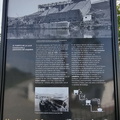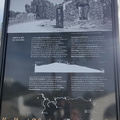Information Board outside the mining museum at El Granado (5) (via Google Translation)
(heading) THE PORT OF LAJA - The importance of the loading dock
(top left photo) Vessel turning in front of the Port of La Laja to start the descent of the Guadiana. The size of the ship gives shows the great width of the river at this point. (top right photo) Ships loading in Puerto la Laja, in October 1933.
(bottom left photo) Branch of the track arriving at the dock platform. (bottom right photo) The merchant Cantiquin Mine during ore loading, in June 1953.
(main text) The core of La Laja was born as a settlement of river fishermen, prior to mining. The dock arose later, limited to old ships and steamships to export the pyrite from the Portuguese mine of São Domingos and the small sporadic shipments of manganese from the exploitations of the Spanish margin. The Guadiana has been since the 19th century a way out to markets and the most prominent ports of the time. It was in the 1850s, when the Santa Catalina manganese mine began to be exploited, reaching up to 125,000 tons in 1870, coming downstream from the pier of the Port of La Laja. The boom of the loading dock arises with the arrival of the company The Bede Metal and the construction of the railway and the aerial cable. This allowed the Newcastle company to go from 4,500 to 10,000 tons exported in crude. The enormous mining activity made the port of La Laja one of the main ones in the Iberian Peninsula. In front of the pier, the meander of the Guadiana has a great width, which allowed the turning of the boats, to which the numerous dredging carried out. With all this, materials such as pyrite, manganese, copper shell, silver galenas, litharge and lead, among others, were exported from here, receiving in turn coal, which was used to move the trains, wood, industrial machinery and scrap metal.
- Created on
- Thursday 29 December 2022
- Posted on
- Sunday 1 January 2023
- Albums
- Visits
- 774
- Rating score
- no rating
- Rate this photo

